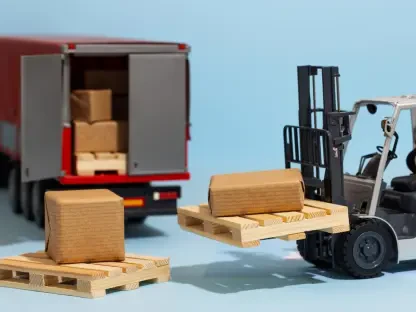With decades of experience in the Logistics industry, Rohit Laila has become a prominent figure in the realm of warehouse safety and racking inspections. His passion for technology and innovation serves as a driving force behind his commitment to ensuring safe and efficient supply chain environments. In today’s interview, we delve into the best practices and legal requirements for maintaining racking systems, uncover common pitfalls, and explore the role of dedicated safety personnel.
What are the key benefits of having a tailored racking and shelving system in a warehouse?
Having a tailored racking and shelving system in place significantly boosts operational efficiency and safety in a warehouse. Such a setup optimizes space usage, allowing for better organization and easier access to inventory, which enhances productivity. Moreover, it can be designed to accommodate specific types of goods, reducing the risk of damage and improving overall workflow.
Why is it important to have a continuous inspection process for racking and shelving systems?
A continuous inspection process is vital because it ensures that racking systems remain safe and functional over time. Regular checks help to identify any damage or wear before they become major issues, minimizing risks to staff and products. This proactive approach not only maintains compliance with safety standards but also prevents costly downtime due to equipment failure.
What are some common issues Teepee encounters during Expert Inspections?
During Expert Inspections, it’s not uncommon to find that routine checks are neglected or repair recommendations are not addressed. These oversights can lead to significant safety risks and potential legal issues. Other frequent findings include compromised structural integrity due to minor damages left unchecked, improperly equipped racking systems, and insufficient load notices.
What are the legal requirements for racking inspections according to HSG76?
The HSG76 guide mandates a comprehensive approach to safety in storage environments. This includes appointing a Person Responsible for Racking Safety (PRRS), ensuring they undergo proper training, and conducting annual inspections by qualified professionals. These steps are necessary to maintain compliance and ensure the integrity of racking systems is consistently evaluated and maintained.
Who should be appointed as the Person Responsible for Racking Safety (PRRS)?
Typically, a warehouse, facilities, or health and safety manager is appointed as the PRRS. This individual should have the authority and capability to enforce safety measures, oversee inspections, and ensure maintenance protocols are followed. They’re responsible for maintaining safety standards and keeping records up to date.
What qualifications and training should a PRRS have to effectively uphold safety standards?
A PRRS should have adequate training that equips them to spot and categorize various levels of damage to racking systems. Ideally, they would undergo a Rack Safety Awareness course to gain the necessary skills. This training should cover key aspects such as legal requirements, damage identification, and maintenance protocols, preparing them to either handle issues directly or delegate tasks appropriately.
How does a PRRS categorize different levels of damage to racking systems?
A PRRS uses specific criteria learned in their training to identify and categorize damage. Damages are typically categorized from minor, which might require simple monitoring, to severe, which necessitates immediate action. This categorization allows for a systematic approach to addressing issues before they escalate into major safety concerns.
What records and data should a PRRS maintain and analyze?
A PRRS should keep detailed records of all inspection results, maintenance activities, and incident reports. Analyzing this data is crucial for identifying patterns and potential problem areas, facilitating informed decisions for ongoing improvements in safety protocols. Accurate records also ensure compliance with legal requirements and provide a basis for future inspections.
Can you explain the purpose and content of a Rack Safety Awareness course?
A Rack Safety Awareness course aims to educate team leaders and supervisors on the inspection and maintenance of storage equipment. It covers identifying damage, understanding legal requirements, key components of racking, and maintaining load notices. This comprehensive training enhances their ability to maintain safe working environments effectively.
Who should attend a Rack Safety Awareness course, and what skills should they gain?
Team leaders, supervisors, and managers responsible for maintaining warehouse safety should attend this course. They should gain skills in identifying and documenting damage, understanding safety regulations, and interpreting safety data. These skills enable them to proactively manage risks and implement effective inspection routines.
What qualifications should an individual have to perform an Expert Inspection?
An individual performing an Expert Inspection should possess relevant industry qualifications, such as the SEMA Approved Racking Inspector (SARI) certification. This ensures they have the technical know-how to accurately assess racking systems, not only identifying visible damage but also providing broader guidance on warehouse safety.
What does an Expert Inspection entail beyond identifying damage?
Beyond identifying damage, an Expert Inspection involves reviewing warehouse operations’ overall safety and efficiency. This includes assessing the suitability of racking systems, ensuring proper housekeeping, verifying load notices, and giving recommendations for improvements. The goal is to foster a safe, well-organized warehouse environment.
What are the responsibilities of a warehouse owner or manager regarding inspection processes?
Warehouse owners or managers are responsible for implementing and overseeing a robust inspection process. This includes ensuring regular visual inspections, maintaining records, validating staff training certifications, and addressing repair needs promptly. They must also ensure that expert inspections are scheduled and that any safety recommendations are actioned immediately.
How often should visual inspections be carried out and formally reported in a warehouse?
The frequency of visual inspections can vary but generally should be conducted weekly to effectively monitor conditions. These inspections should be formally reported to ensure accountability and track any emerging issues, contributing to an ongoing cycle of safety and maintenance within the warehouse.
What measures should be in place to ensure continuous inspection coverage during staff absences?
It’s crucial to have cross-trained staff or a succession plan that enables other qualified team members to take over inspection duties during absences. This maintains inspection continuity and compliance with legal requirements, ensuring that no part of the safety process is overlooked.
Why is it crucial to validate staff training certificates regularly?
Regular validation of staff training certificates ensures all personnel handling inspections and maintenance are adequately trained and current in their knowledge. This validation process supports ongoing safety compliance, as the landscape of industry standards and regulations can evolve.
What could be the legal implications of not completing repairs within the recommended time frame?
Failure to complete repairs on time can result in significant legal consequences, such as fines and increased liability in the event of an accident. It reflects non-compliance with safety mandates, exposing the business to potential lawsuits and operational disruptions.
How can Teepee assist businesses with their inspection and training needs?
Teepee offers a comprehensive service package that includes scheduling expert inspections, providing racking repair services, and delivering training programs. These support services are designed to help businesses maintain high safety standards, fulfilling legal requirements and enhancing operational efficiency.
Do you have any advice for our readers?
Embrace a proactive approach to warehouse safety, continuously invest in training, and ensure that all systems and processes are regularly evaluated for effectiveness. Safety is an ongoing commitment that not only protects workers but also drives operational success.









